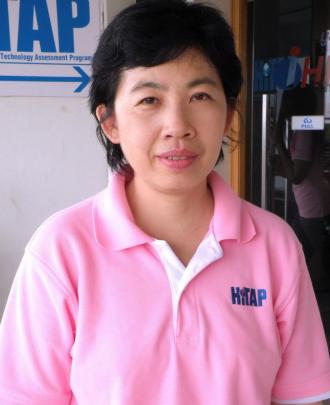Project Summary
Cervical cancer is the major health problem among Thai women over a decade. There were an attempt to establish cervical cancer screening in Thailand for 40 years in order to reduce its incidence and mortality. Prior to the year 2005, the low coverage rate of the screening was observed. As a result, the cervical cancer screening programme in Thailand was initiated and implemented in the national level since the 2005. The purpose of this study is to assess the Pap smear and VIA screening programme in terms of services coverage, efficiency and barriers to the service utilization from women’s and health care providers’ perspective.
A cross-sectional household survey was conducted between September 2009 and May 2010 in 12 provinces in Thailand. Face-to face structured interview was conducted among women aged 30-60 years old, the target population of the Department of Health. Sets of questionnaires were mailed to every public health staff and health administrators who involved in the cervical screening programme. A total of 4,600 women were randomly selected by stratified four-stage sampling whereas a total of 3,600 samples of health care providers were purposively selected. Of these samples, 4,512 women and 1,943 health care providers consented to involve this study. Descriptive statistics and logistic regression were employed. The important aspects derived from this study are; - within 5 years, 68% of Thai women undertook cervical cancer screening at least once. The coverage of the screening programme has increased significantly during the past 2 years. There was no significant difference between the uptake rates from the 12 study sites. - the survey also showed that the most common reasons that barred respondents to undertake the cervical cancer screening included the absence of indications or symptoms, lack of time and feeling shy. - a multivariate logistic regression analysis indicated that the supporting factors contributed to the service seeking behavior were 40-50 years of age, worked in agriculture, experience child-bearing, had at least one family member with cervical cancer diagnosis, received information regarding cervical cancer and the screening, and resided in urban areas. Meanwhile, respondents, who were less likely to obtain the screening tests (impeding factors), were cigarette smokers, misunderstood that the effectiveness of the cervical cancer screening will be life-long, perceived that the screening tests were provided only in hospital settings.
- most of health care providers ranked cervical cancer as a high important public health problem. The majority of health care providers reported good understanding on the policy and the objectives of the two screening techniques. Most of them did not believe that providing national cervical cancer screening would increase their workload.
- the results from the national cervical cancer screening programme demonstrated that screening programme was very well-established during 2009 and 2010. The reasons behind this successful
programme are 1) sufficient materials allocated to health facilities and 2) availability of information regarding to the disease and its screenings, advocated by village health volunteers and public media. Furthermore, the coverage of cervical cancer screening programme rose especially during 1-2 years ago because of the combination of strong public campaign, national policy and increased budget from the Ministry of Public Health plus increased budget incentive.
There were several factors associating with the service seeking behavior among women in this study. In order to increase the service utilization, relevant agencies needed to carefully address all
associated factors. The findings of this study suggested that the service coverage can be significantly improved by enhancing better communication strategy regarding knowledge and perception of the cervical screening, tailoring the interventions to suit sub-group of population where cultural difference existed, organizing trainings to allow public health staff to perform the screening test and creating effective monitoring and evaluation of the cervical cancer screening programme.
It is recommended that;
1. Enhance correct knowledge and positive attitudes towards cervical cancer screening to fit specific characteristics of subgroups
- Rural and remote areas conducting health communication through local media and network such as health volunteers, health professionals and community meetings
- Urban areas increase mass media promotion, for instance, television, radio, cable TV including posters in public places
- Smoking women emphasize public media and campaigns with non-profit organizations such as the Action on Smoking and Health Foundation Thailand, the Tobacco Control Research and Knowledge Management Center, and the Friends of Women Organization
2. Adjust patterns of service provision to suite the context of the low coverage settings
- Muslim female waive a cervical cancer screening service during the Fasting period, create understanding and positive attitudes for heads of families and religious leaders
- Female stay in urban areas deliver a cervical cancer screening to workplaces, companies, factories, accommodations -Outreach areas increase accessibility and incentive such as presents, lucky draw and combined cervical cancer screening with other health promotion and promotion programmes
3.Training health professionals and set up an effective monitoring and evaluation system -Annual training for health professional to ensure that every staff can perform a standard Pap smear and VIA -Set up a regular and effective monitoring and evaluation system
4.Improve software for data registration -Improve software that allows good flow of screening, follow up and treatment processes -Support surveillance system -Experience sharing and brush up training for staff at least once a year
5.Provide cervical cancer screening programme continuously -Crate incentive and maintain health care providers in the health care system -Clear national policy on cervical cancer screening including administration that can boost the effectiveness of the programme -Continuously promote correct knowledge and positive attitudes towards cervical cancer and screening -National long term plan to tackle with cervical cancer such as decrease morbidity from 2,000 cases to <1,000 cases in 5 years from now and











